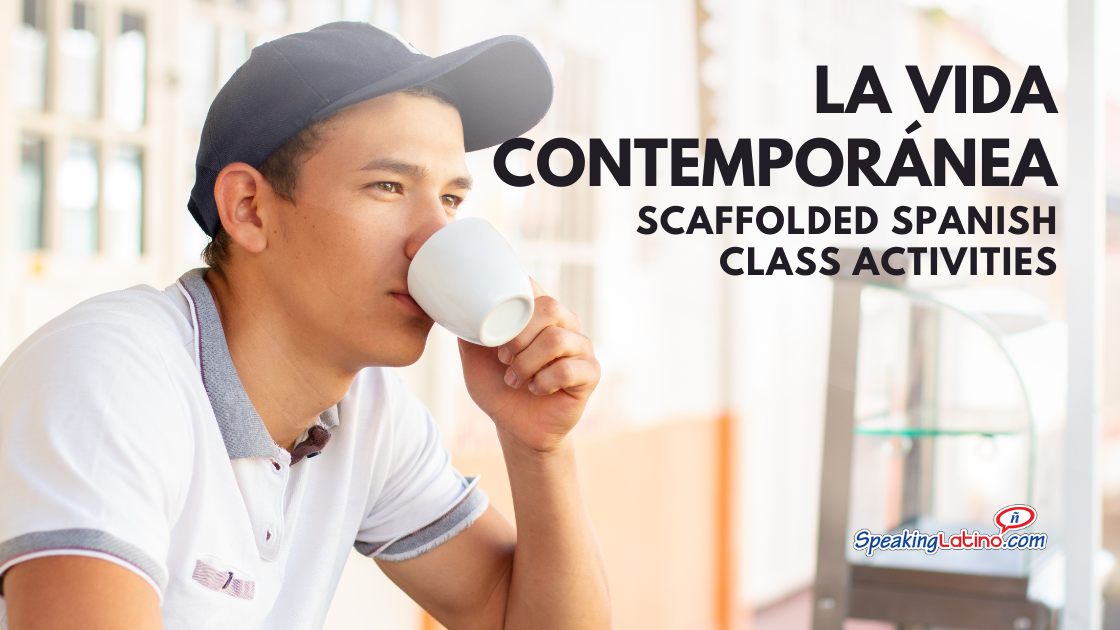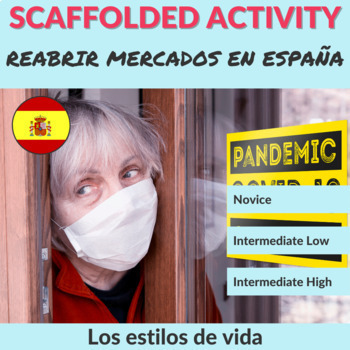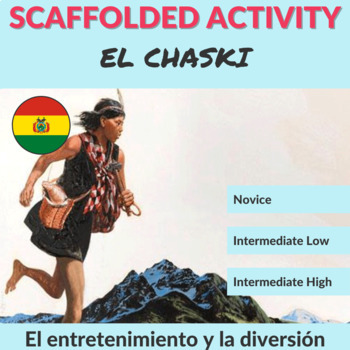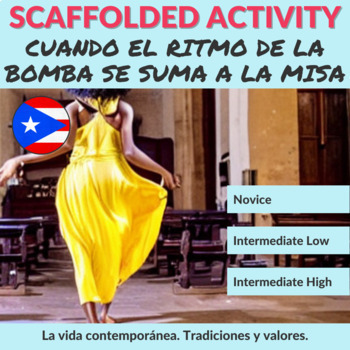
As Spanish teachers, we all know how important it is to incorporate cultural activities in our language classes. It not only enhances language proficiency but also promotes intercultural understanding and respect. However, finding relevant and scaffolded activities for different levels can be a daunting task. Here are 13 suggested Spanish class activities about Contemporary Life that brings Hispanic culture to all your classes every month, from novice to advanced levels.
These scaffolded activities have been carefully adapted for each level, so you don't need to worry about researching, adapting, or thinking about tasks for each level. We call it the "perfect mix between culture and language proficiency", including activities for reading, speaking, and writing based on authentic resources.
One of the best things about these activities is that it's a huge time-saver for teachers with mixed classrooms or multiple level classes. Each activity comes in three scaffolded versions - novice, intermediate low/mid, and intermediate high/advanced - with teacher's notes for each proficiency level, including guides on what to do before, during, and after the activity. An answer key is also included, making it easy for you to assess your students' progress.
Start incorporating these activities into your classes today and see the difference they make in your students' language proficiency and cultural understanding.
La Vida Contemporánea: Spanish Cultural Activities
The following suggested activities about La Vida Contemporánea cover cultural topics such as canopy tours in Monteverde, Costa Rica, bullfighting in Spain, Antonio Gaudí's architecture in Barcelona, and the Plaza de España. These topics offer insights into diverse aspects of Hispanic culture, fostering intercultural understanding and language proficiency among students.
1. Antonio Gaudí: Los estilos de vida (España)

In this reading comprehension activity, students learn about the Spanish architect and artist Gaudí, his work, and how he contributed to Barcelona, Spain. They explore the art of Gaudí and understand how it has an impact on modern life. As a teacher, you have the opportunity to transform the activity into an artistic project!
- Novice students read a text, learn new words in context, answer questions written in English, exchange information with a partner, and describe orally the architecture and functionality of buildings in their own communities.
- Intermediate Low/Mid students use a graphic organizer to brainstorm their ideas and compare orally their communities to Gaudi’s.
- Intermediate High/Advanced students read a detailed description of two of Gaudi’s work, answer questions written in Spanish, and compare the two works described with places in their communities explaining how they contributed to contemporary life.

In this reading comprehension activity, the students read and learn about the tradition of bullfighting in Spain and how it has an impact on people from different ages. Students will find this activity challenging because they will learn about a controversial tradition in Spain that they may not be aware of. By completing this Reading Comprehension activity, your students will have the chance to discuss, and give their opinion, about animals’ rights!
- Novice students are encouraged to talk about how popular bullfighting is today compared to the past, and how they feel about it after reading the Spanish people’s opinions.
- Intermediate Low/Mid students are also asked to give their opinion about bullfighting and explain why they feel that way.
- Intermediate High/Advanced students are given detailed information about the place where bullfighting is still a tradition; they read the complete interview and are asked to write an email to express their opinion.

In this reading comprehension activity, students learn about El Salar de Uyuni, a salt flat in Bolivia, and talk about excursions for tourists. Students will turn into tourist guides!
- Novice students read the information about El Salar de Uyuni, match images to vocabulary, write true or false, and talk to a partner about excursions.
- Intermediate Low/Mid students read all the instructions in Spanish.
- Intermediate High/Advanced students read a complete description of excursions and write questions for the paragraphs, speak with a partner, and prepare a package for tourists.

In this Reading Comprehension activity, students learn about doing “canopy” in Monteverde, Costa Rica. They read a text and look at visual content to find information about the forest’s tours. This activity will be challenging for any student, as they have the chance to experience a tour in the forest and imagine doing canopy in Costa Rica!
- Novice students read the text, answer questions written in English, match specific words and phrases with images, and learn about forests and tourists' activities.
- Intermediate Low/Mid students answer the questions in Spanish and interpret the visual text.
- Intermediate High/Advanced students read information, opinions and comments from TripAdvisor, and write in detail their own experience in the tour.

In this Reading Comprehension activity, students read about schools in Bolivia and learn about a project UNICEF is carrying on monitoring the quality of Education. Students are the main characters in Education, and they will feel empowered to give their opinions and talk about what they think is right!
- Novice students read the article adapted from UNICEF, match Spanish vocabulary with its translation in English, complete a ‘true or false’ activity written in English, and give their opinions about the importance of education.
- Intermediate Low/Mid students also elaborate opinions based on statements and talk about the importance of access to education in groups.
- Intermediate High/Advanced students think about education and discuss UNICEF’s solution giving their opinions and comparing other countries.

In this writing activity, students read a webpage about Parque Nacional Manuel Antonio, a park in Costa Rica that offers excursions and different activities and complete a writing activity. Students practice writing, but also express their opinion and care for the environment.
- Novice students read the webpage, look at the images and information from the park, and write an email to ask for information.
- Intermediate Low/Mid students get the instructions to write an email of between 100-150 words in English.
- Intermediate High/Advanced students write an email expressing their points of view about the impact of tourism on the environment in Costa Rica.

In this reading comprehension activity, students read about la Plaza de España. They go through the travelers’ opinions to discover its monuments, traditions, and architecture. Students see Plaza de España through the tourists’ eyes, learn some interesting facts about this iconic place, and compare it to landmarks from their own cities. They can become tourists and travelers while they learn the lesson!
- Novice students read the travelers’ opinions and some basic information, and answer questions written in English, discuss the reading with a partner, and identify cognates in the text.
- Intermediate Low/Mid students answer the questions written in Spanish.
- Intermediate High/Advanced students write a review of a place of interest from their cities, where they express their opinions and make recommendations for tourists.

In this visual comprehension activity, students read about the public transport service provided by Tracopa, a company from Costa Rica, and how citizens and tourists travel in the country. They learn how public transport works in Costa Rica. They watch videos and surf the website for a real experience!
- Novice students read and surf the company’s website and answer questions based on the information from the charts.
- Intermediate Low/Mid students also look at a map and the FAQ, answer questions and find synonyms in the text.
- Intermediate High/Advanced students write elaborate answers to the questions and give their opinion in an oral presentation about how public transport influences communities and tourism.

In this reading comprehension activity, students read about the Ecological Park where Volcán Arenal is in Costa Rica and view incredible images from the park. Students will interact the same way they do on Instagram.
- Novice students read an Instagram post, look at images, and learn vocabulary and answer questions in Spanish.
- Intermediate Low/Mid students also react to the Instagram post and write a comment.
- Intermediate High/Advanced students answer more detailed questions and prepare their own post for the social media platform.

In this reading comprehension activity, students learn about the reopening of the markets in Madrid, Spain. They read an article about the measures taken by the government to protect the community from COVID-19, and they compare how different countries reacted to the virus. They read news and learn what is happening in the world regarding COVID-19. They will give their opinion about how governments are proceeding.
- Novice students read a newspaper article adapted to their level, answer questions written in English, look at words in context, and they compare the reopening in their own community to Madrid, by brainstorming ideas and using specific phrases.
- Intermediate Low/Mid students are also asked to use phrases of uncertainty to express their ideas.
- Intermediate High/Advanced students read a more detailed text, exchange what they understand with a partner, and brainstorm ideas to talk about similarities and differences between Madrid and their community.

In this reading and visual comprehension activity, students learn about El Chaski, an old Bolivian magazine for children that went digital. They will learn about the comeback of an old children’s magazine, and they will become artists by creating their own!
- Novice students read information about the magazine, solve a short and simple quiz looking at the picture, and create their own magazine for children writing personal information.
- Intermediate Low/Mid students also answer questions about the picture and write a section of the magazine.
- Intermediate High/Advanced students read an article with detailed information, match phrases with the texts, complete the bubbles of a cartoon, and make their own magazine.

In this Reading Comprehension activity, students learn about Pachamama day, a tradition in Bolivia when people celebrate with offerings to the Earth. Students will enjoy learning, comparing and talking about cultural differences between modern life and native communities. They will also have the opportunity to defend their rights!
- Novice students read a newspaper article to learn about Pachamama and the offerings made to fight the COVID-19. They search and learn words related to the celebration, and answer questions written in English.
- Intermediate Low/Mid students answer questions written in Spanish and also talk about what they read, comparing this celebration to their countries’.
- Intermediate High/Advanced students answer questions and prepare a presentation to talk about indigenous communities and cultural differences.
13. Cuando el ritmo de la Bomba se suma a la misa: Tradiciones y valores (Puerto Rico - Afro-Latinos)

With this visual interpretation activity, students learn the story of a Catholic church in Puerto Rico where a weekly mass is celebrated with Bomba, a traditional dance and musical which origins are rooted in the island's history of African slavery.
- Novice students: After doing brief research about the Puerto Rican Bomba, students watch a news clip where they will see la Bomba being performed in an unusual setting: the church Parroquia Espíritu Santo y San Patricio in the town of Loíza. They will relate images from the video with the correct word in Spanish.
- Intermediate Low/Mid students: After doing brief research about the Puerto Rican Bomba and the town of Loíza in Spanish, students watch a news clip where they will see la Bomba being performed in an unusual setting: the church Parroquia Espíritu Santo y San Patricio. They will describe some images from the video and determine which ones are religious or African related. Then, they will read some quotes from the video and determine who said each one of them.
- Intermediate High/Advanced students: After doing brief research about the Puerto Rican Bomba and the town of Loíza in Spanish, students watch a news clip where they will see la Bomba being performed in an unusual setting: the church Parroquia Espíritu Santo y San Patricio. They will describe some images from the video and determine which ones are religious or African related. They will also formulate follow-up questions that could be asked in a future news report. Finally, they reflect in one of the quotes from the church's choir director.
Activity Structure and Resources to Assess Student Progress
The activities are structured to cater to different proficiency levels by providing scaffolded versions for novice, intermediate low/mid, and intermediate high/advanced students. Additionally, resources are included to help teachers assess student progress effectively:
1. Scaffolded Versions:
- Novice Students: For novice students, the activities focus on introducing basic concepts and vocabulary, with questions and tasks written in English to facilitate comprehension.
- Intermediate Low/Mid Students: Intermediate students engage in more complex tasks, such as answering questions in Spanish or comparing their communities to the content presented in the activities.
- Intermediate High/Advanced Students: Advanced students tackle more challenging tasks, such as writing reviews, expressing opinions, and making recommendations related to the topics covered in the activities.
2. Assessment Resources:
- Answer Key: An answer key is provided with the activities, allowing teachers to quickly check student responses and provide feedback on their progress .
- Teacher's Notes: Detailed teacher's notes are included for each proficiency level, offering guidance on how to assess student understanding and language proficiency before, during, and after the activities.
- Opportunities for Oral Assessment: Some activities involve oral discussions, presentations, or descriptions, providing teachers with opportunities to assess students' speaking skills and comprehension.
- Written Assignments: Activities may include written assignments, reviews, or descriptions that allow teachers to evaluate students' writing skills and ability to express themselves in Spanish.
By providing scaffolded versions tailored to different proficiency levels and including assessment resources such as answer keys, teacher's notes, and varied assessment opportunities, these activities offer comprehensive support for Spanish teachers to effectively evaluate and track student progress in language proficiency and cultural understanding.
Time-Saver for Teachers With Mixed Classrooms or Multiple Level Classes
Let's explore why these 13 suggested activities are designed to streamline class planning and implementation for teachers with mixed classrooms or multiple level classes:
1. Ready-to-Use:
- The activities come in three scaffolded versions for different proficiency levels - novice, intermediate low/mid, and intermediate high/advanced - eliminating the need for teachers to create separate materials for each level.
- Teachers can simply choose the appropriate version of the activity based on their students' proficiency levels, saving time on adapting resources for different groups of learners.
2. Comprehensive Teacher's Notes:
- The activities include detailed teacher's notes for each proficiency level, providing guidance on what to do before, during, and after the activity.
- These notes help teachers effectively implement the activities in the classroom, ensuring smooth execution and maximizing learning outcomes without the need for extensive preparation.
3. Answer Key Provided:
- An answer key is included with the activities, making it easy for teachers to assess student progress and provide feedback efficiently.
- Teachers can quickly evaluate student responses and track their language proficiency development, saving time on grading and assessment tasks.
4. Variety of Activities:
- With 13 scaffolded activities covering different aspects of contemporary life in Hispanic culture, teachers have a diverse range of options to choose from for their classes.
- This variety allows teachers to keep lessons engaging and relevant to students of varying proficiency levels, catering to the needs of mixed classrooms without the extra effort of creating multiple resources.
Endless Options to Explore More Cultural Themes
Explore the additional set of activities to enrich your Spanish classes with a wider range of cultural topics tailored to every proficiency level.
1. La belleza y la estética - Activities tailored to different proficiency levels, exploring diverse cultural topics related to beauty, aesthetics, and heritage in Argentina, Colombia, and Ecuador. Through a combination of reading comprehension, vocabulary building, and critical thinking exercises, students enhance their Spanish language skills while gaining valuable insights into the richness of Spanish-speaking cultures.
2. La Identidad Pública y Privada - These suggested activities designed around the AP Spanish theme of La identidad pública y privada or public identities in the Spanish-speaking world, but they have been also adapted for students at novice and intermediate proficiency levels.
3. La Vida Contemporánea - This set of activities cover cultural topics such as canopy tours in Monteverde, Costa Rica, bullfighting in Spain, Antonio Gaudí’s architecture in Barcelona, and the Plaza de España. These topics offer insights into diverse aspects of Hispanic culture, fostering intercultural understanding and language proficiency among students.
4. Las Familias y las Comunidades - Dive into traditions, values, and challenges faced by families and communities in the Spanish-speaking world with differentiated activities featuring Peru, Dominican Republic, Chile, and Uruguay.
5. La Ciencia y la Tecnología - Students engage in various activities that explore the theme of science and technology in Colombia, Paraguay, Guatemala, Cuba, and among indigenous communities.
6. Los Desafíos Mundiales - Explore global challenges across all student's level with these activities featuring Puerto Rico and Equatorial Guinea. They will get to explore topics like natural disasters, environmental conservation, social challenges, and cultural aspects. It's all about real-world issues while improving their Spanish skills.
7. Afro-Latinos Scaffolded Cultural Activities - Use these scaffolded activities in any order during Black History Month or through the school year. Each activity includes 3 versions to use with novice, intermediate low-mid, and intermediate high-advanced students.